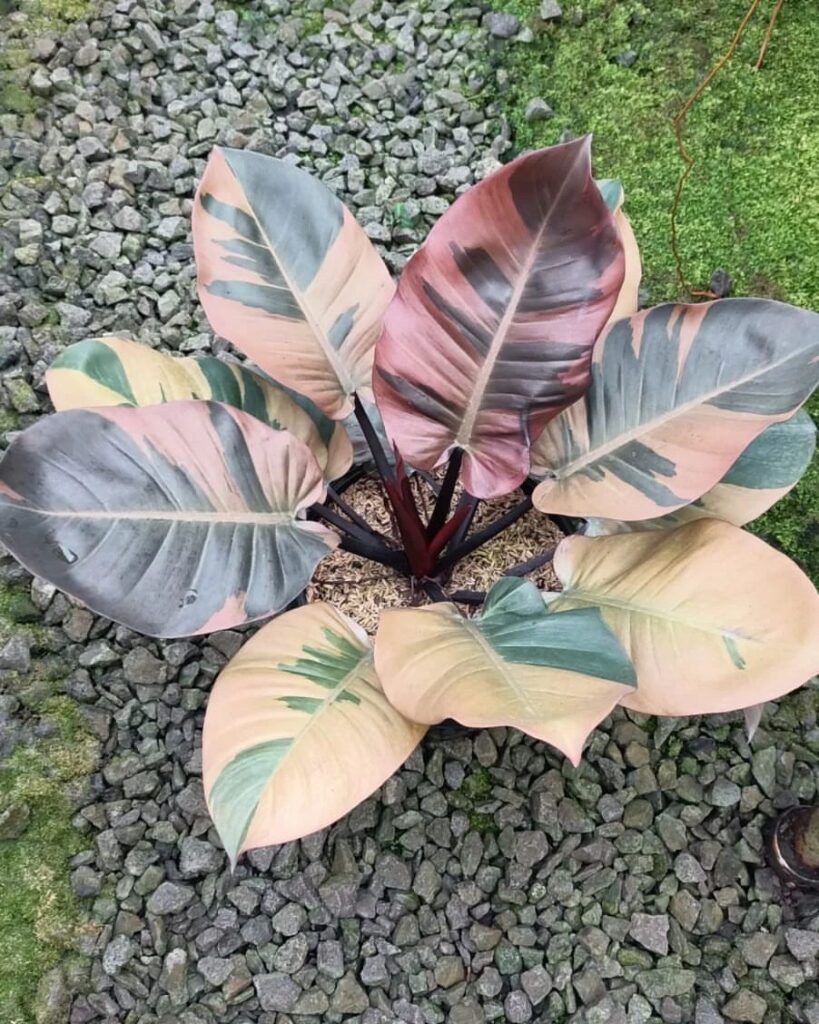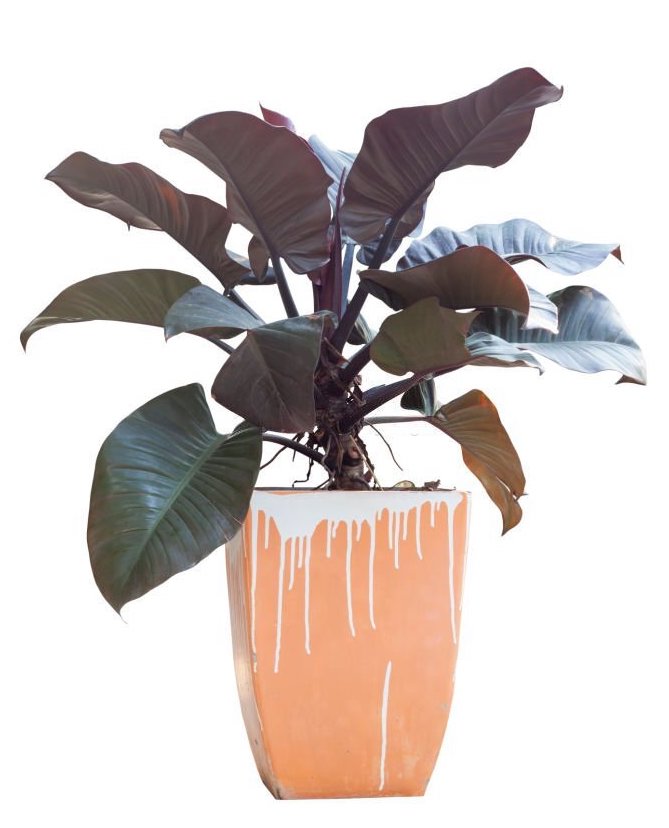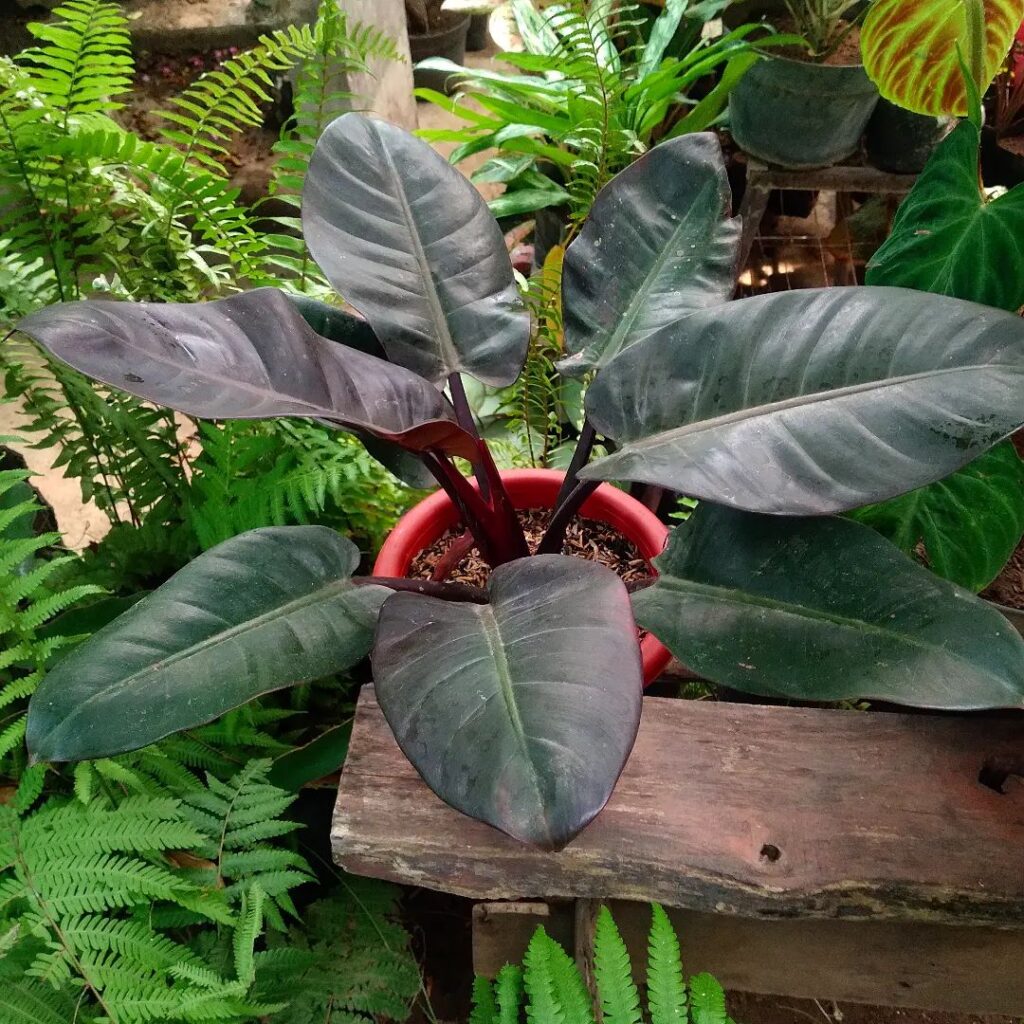Philodendrons are tropical plant species with attractive leaves. They don’t need much care, so they make good houseplants. One Philodendron variety, the Philodendron Black Cardinal, is an excellent choice because it requires little maintenance and has an eye-catching appearance.

It is a small-sized plant species that grows to a height of 3 feet. Its developing leaf is bronze to burgundy before turning a rich blackish green.
The Black Cardinal usually lives in the understory of tropical forests. It will be happy in a warm, bright spot with indirect light, soil that drains well, and regular watering.
With these conditions, you’ll have a happy, healthy plant that will need a new pot every few years and won’t get many pests or diseases.
Read and follow the easy care guidelines in this article to guarantee your precious black cardinal thrives.
RELATED: 9 Stunning Rare Philodendrons; With Tips To Help Them Thrive
Profile

General Information
The Black Cardinal Philodendron Plant was first hybridized in the early 80s in Florida. Having striking leaves and requiring little upkeep, the broad, the Philodendron Black Cardinal appearance, with color-changing leaves which change from burgundy to dark green to black, differ from the common heartleaf species.
This plant loves temperate, tropical, or subtropical climates, and warm, protected settings. Additionally, this plant is a cultivar of a man-made hybrid.
The well-known Blushing Philodendron is one of the hybrid’s parents. Despite the plant’s slow rate of development, it is easy to care for.
Etymology
The Greek words Philo and dendron, which translate to “love” and “tree,” respectively, are the origin of the name “Philodendron.”
However, the word “black cardinal” may come from a bird’s name, which is Phainopepla, or from the word “dark cardinal,” which means dark red that is yellower and less strong, as that is how the plant appears to be colored.
Flowering
Although Black cardinals rarely flower, when they do, you will notice a dark red spathe wrapped around a white spadix, and they bloom more frequently in the summer. However, the flowers aren’t as pretty as the leaves. It stands out in any plant collection because of how pretty its leaves are.
Season Of Interest And Purchasing
Most types of Philodendron, like the Philodendron Black Cardinal, grow profusely during spring and summer growing season and reach a mature height of about three feet.
Philodendron “Black Cardinal” variegated is a rare variation of the well-known “Black Cardinal” cultivar. Additionally, it might be the most exquisite variegated Philodendron available around the commercial market.
Growth
The Black Cardinal Philodendron is a small-sized cultivar that reaches heights of 3 feet (0.9 meters) and widths of 1.5 feet (45.7 cm). It grows slowly, and it might take 10 years for it to get to its full size. Each oval leaf can get up to 1 foot (30.4 cm) in length and 8 inches (20.3 cm) in width.
Growing Philodendron Black Cardinal Plant is easy as it was designed to be self-heading, which means that it doesn’t climb and instead grows into a neat rosette on its own.
Philodendron Black Cardinal Overview
| Scientific name | Philodendron erubescens “Black Cardinal” |
| Common names | Black Cardinal Philodendron |
| Family | Araceae |
| Growth Habit | Herbaceous, Epiphytic Vine |
| Height and Spread | up to 3 feet in height, and 1.5 feet in width |
| Classification based on life cycle | Perennial |
| Origin and Distribution | Native to Tropical Regions in Caribbean, South America, and Central America |
| Climate Zone | Generally mild climate |
| USDA Plant Hardiness Zone | USDA Zone 10-12 |
| Color | Large leaves that ranges from bronze to burgundy to blackish green |
RELATED: 11 Frequently Asked Questions on How to Care for a Philodendron Birkin
Care Tips
Light Requirement
The ideal environment for the Black Cardinal is one that is cozy, bright, and has indirect light for healthy growth.
Give your Black Cardinal’s leaves the right amount of exposure to sunlight—neither too much nor too little—to bring out their vibrant color.
The optimum location for them is close to a window where the sun’s rays won’t hit the leaves directly. If the leaves start to turn yellow, they may be receiving too much sun.
The stems will lengthen, and the leaves will spread apart by several inches if they don’t receive enough sunlight.
Temperature Requirement
The average temperature inside a house is actually fine for your Black Cardinal. A room that is kept between 65 and 78 degrees Fahrenheit during the day and at least 60 degrees Fahrenheit at night is the optimal temperature requirement for this plant.
It can only be cultivated outdoors year-round in tropical or subtropical areas since it can’t withstand freezing conditions without suffering from foliage. It can tolerate temperatures below 55 degrees Fahrenheit but not much below that.
Water Requirement
Black Cardinal plants require the same amount of water as other Philodendrons to thrive. Give your plant a good bath when watering.
Although they prefer dry soil, it shouldn’t go completely dry in between waterings either. When the top inch of soil seems dry, water your plant. You can test this by sticking your finger beneath the surface to see if it’s still damp.
If you notice the leaves curling, this indicates that you are either under or overwatering, so keep an eye out for this.
Water until the moisture flows out of the drainage holes. Water regularly during the spring and summer, then less often in the fall and winter as the plant becomes dormant.
Humidity Requirement
The natural rainforests where the Philodendrons thrive are extremely humid, with relative humidity reaching up to 70%. This kind of humidity level is what black cardinals love, although this plant doesn’t need a lot of it to survive.
Both humidity levels between 40 and 50 percent are acceptable, but higher humidity promotes faster growth.
To increase humidity levels, fill a tray with small pebbles and water and/or group together all your plants in order to create a more humid environment. You may also utilize a humidifier for you to target humidity and air in your plants’ surroundings.
Soil Requirement
Philodendrons require well-draining soil with abundant organic matter to stay hydrated. By mixing compost with perlite, peat moss, or vermiculite, you can create the ideal soil for your Black Cardinal that holds onto moisture while letting extra water drain.
You can purchase a commercially available soil mix for Philodendron Black Cardinal, such as an African violet or an Aroid mix. These mixtures will easily drain out excess water while preventing the roots from drying out. The ideal pH range for Philodendron Black Cardinal soil is 5.5 to 6.5, or acidic to moderately acidic.
Fertilizer Requirement
You can fertilize once a month in the spring and summer and once every six to eight weeks in the fall and winter if you want to promote steady development of your plant. The easiest fertilizer for Black Cardinals is a liquid formula. Dilute it to half the NPK recommendation (nitrogen, phosphorus, and potassium).
Space Requirement
Philodendron Black Cardinal doesn’t take up much room in your home, growing to a height of about three feet and a width of about a foot and a half.
The Black Cardinal’s medium size and its dark, nearly black leaves make it possible to have a modern look ideal for city lofts, put them on a shelf, or hang them from a hook. They also are perfect houseplants in more conventional settings.
Growing and Planting Tips
Propagation
To propagate Philodendron Black Cardinal, you can do it by rerooting parts of the stem or dividing them while repotting.
Propagation via rooting stem sections:
Taking stem cuttings and rooting them in water is the simplest method for propagating your black cardinal.
To do this, cut a bit from the base of your Philodendron and place it in a small container filled with water. If the water becomes contaminated, replace it, then wait until some white bumps appear and start to turn into roots.
Place the glass in bright, indirect sunlight. Put these cuttings in a suitable potting mix as soon as the roots have grown at least two inches long.
Propagation via plant division:
Carefully remove and untangle a piece of roots from their respective stems. You can repot it into its own container once you’ve detached it from the mother clump. Repotting is an excellent opportunity to propagate your plant from the root.
Maintain it well, place it in filtered sunlight, and water it according to the recommended schedule.
Pruning
Pruning Black Cardinals is not required very often. However, it is also necessary to keep your Philodendron black cardinal looking nice and to keep pests and diseases away.
As the leaves wilt and turn yellow, remove them along with any other damaged parts. You can also prune the plant to the desired size to keep it tiny.
Potting and Repotting
You should give your Philodendron Black cardinal new room in a distinctive container when it reaches a certain size in order to maintain its health and growth.
Depending on its growth habits, repotting for the Philodendron Black Cardinal only needs to be done every few years.
It’s time to repot your Black Cardinal into something roughly 2 inches larger once it has filled out its current container, which can severely harm or kill the plant. The ideal season is early spring. Ensure that the pot has adequate drainage holes.
Philodendron Black Cardinal Care
| Light | Bright indirect light |
| Temperature | Intermediate to warm, 65-78 degrees Fahrenheit |
| Water | Once a week, increased in summer, decreased in winter |
| Soil | Airy, well-draining soil; not too loose; African Violet or Aroid Soil Mix |
| Fertilization | Regular household fertilizer or liquid formula, once a month in spring and summer, every 6-8 weeks during fall and winter |
| Space | Substantial amount of space to spread |
| Propagation | Via plant division and root cuttings |
| Blooming | Rarely blooms, enough sunlight and maturity needed |
| Pruning | Regular pruning |
| Potting | Regular potting mix, use of horticultural charcoal, orchid bark, perlite and coco coir |
Problems And Troubleshooting
Overwatering
One of the most typical issues with this plant is overwatering. However, excessive moisture will not kill your plant right away; instead, root rot develops when a plant’s soil is kept too moist, and the roots cannot breathe, resulting in a fungal infection. It will suddenly display signs of stress, such as curling or yellowing leaves.
In order to avoid this issue, be aware of the signs of overwatering, which include how frequently you water your plant, checking the top inch of soil before watering again, using the right potting soil, and making sure your pot has a drainage hole for water to flow out.
Underwatering
Philodendron Black Cardinal shouldn’t get completely dry between waterings and should be watered about once a week, depending on its environment, allowing the top 2 inches of soil to dry out.
Yellowing leaves and browning tips may indicate that your plant is chronically under watered or not properly watered.
Nutrient Deficiency
The slow growth of your plant during the growing season is an indication that it is not receiving enough nutrients. Typically, pale leaves indicate a calcium or magnesium deficit.
A balanced and comprehensive fertilizer will resolve this issue. It’s crucial that your plant gets enough nutrients to thrive.
To make sure your indoor Philodendron stays healthy, feed it a balanced liquid fertilizer that has nutrients in it. You can also buy nutrient-rich, sandy, moist, well-drained soil with a pH between 5.0 and 6.
Flowering Problem
Even on plants growing all year in a tropical climate outdoors, the black cardinal rarely blooms and does not have a regular flowering season.
On the other hand, their striking leaves gave it color and life. Make sure your plant receives the right attention and meets its requirements if it has a chance of flowering. Ample light is also essential for healthy flowering.
Pests
There aren’t many bugs that like to feast on Philodendrons, but you might find aphids and mealybugs. With cotton balls dipped in rubbing alcohol, you can get rid of mealybugs. Pests can be kept away by spraying the plant with water and insecticidal soap every so often.
Good soil, light shade or bright indirect light, and a place that doesn’t get frost.
Diseases
Your Black Cardinal was made to be resistant to many common houseplant diseases, so you don’t need to worry too much.
Root rot is the most common disease that affects philodendron black cardinals. Root rot happens when a plant’s soil stays too wet, and the roots can’t breathe, which leads to a fungal infection. The leaves turn yellow and fall off, and the stems get soft. Meanwhile, the roots turn black and smelly.
You might be able to save your Philodendron black cardinal by cutting off all the diseased parts and replanting what’s left in new soil in a clean pot.
Problem with People and Animals
Toxicity
All philodendrons can be poisonous due to the presence of calcium oxalate crystals in all parts of the plant. These crystals can inflict pain or swelling, thus making Philodendron Black Cardinal toxic.
Keep your Philodendron black cardinal out of the reach of kids and animals.
Philodendron Plants Meaning and Symbolism
Philodendrons are believed to enhance indoor air quality and represent good health, vitality, and wealth. This plant’s leaves are formed like flames, symbolizing the fire element in Feng Shui.
Additionally, Philodendrons are thought to symbolize a love of nature, making them the perfect choice for people who are enthusiastic about gardening and eco-friendly living.
They also represent personal growth, making them the ideal gift for anyone undergoing a major life transition or working to better themselves.
They stand for personal development, making them a fantastic present for someone going through a significant life transition or making changes in their own life.
Philodendron Black Cardinal Symbolism and Meaning
| General Meaning | love of nature, passion for eco-friendly living |
| Symbolism | Personal growth |
Landscaping And Gardening Ideas

Companion Plants
In order to create a variegated patchwork of color and texture, Philodendron black cardinal plants can be paired with other plants.
One of them is the Monstera plant. Because they have similarities, they can make good partners. They both grow in similar environments and require little upkeep.
Additionally, Scheffleras plants can withstand or even like average light, humidity, and water, which is also the habitat for black cardinals; with these plants, it gives your houseplant more drama.
Landscaping Ideas
A little touch of color, drama, and flare may be added to any plant collection by adding Philodendron Black Cardinal. Both indoor and outdoor environments are suitable for using a Philodendron black cardinal.
These leafy plants would look stunning, arranged in a row along a balcony railing. Because it self-heads, this plant is adaptable.
It can be raised in containers as an accent in landscaping. A great understory plant for shady gardens in warm, tropical climates, it makes an excellent houseplant for rooms with lots of natural light and warmth.
| What to plant with | Other Aroids, Monsteras, Bird of Paradise, Areca Palms, Fire Spike, Heliconia, Variegated Arboricola, Croton, Chenille Plant, Pentas, Most Tropical Plants |
| What NOT to plant with | Basically nothing |
Frequently Asked Questions
Can you eat the Black Cardinal?
You can’t eat the Black Cardinal. The leaves have calcium oxalate crystals in them, which are not fatal but can cause a lot of pain and irritation if chewed or swallowed.
What should I do if my kid or animal eats a leaf?
Most pets and kids don’t eat much of the leaf because it hurts so much when they chew on it. If they do eat some of the leaf, they should rinse their mouth and tongue with cold water and call the poison control number.
Additionaly, you can use ice or milk to make the pain go away, but you should always talk to a doctor or vet for advice.
Can a Black Cardinal be grown from a seed?
You can’t grow a Black Cardinal from a seed. Not only do these plants rarely bloom, but they are also a complicated hybrid whose genes wouldn’t show up in the seed.
This makes the Philodendron Black Cardinal rare. To make more Black Cardinals, you have to cut them up, split them up, or grow tissue cultures in a lab.
Final Thoughts
The Philodendron Black Cardinal is a highly popular houseplant because of its distinctive appearance.
With a little drama, it has an eye-catching appearance and requires little upkeep. Its developing leaf is bronze to burgundy before turning a beautiful blackish green.
Its growing season is in the spring and summer, and it enjoys warm, protected environments and temperate, tropical, or subtropical climates.
Despite its stunning beauty, keep your Philodendron Black Cardinal away from children and animals, as it is poisonous.
Editor’s Recommendations
Philodendron Birkin: Its Most Informative Care, Propagation, and Watering Guide
Philodendron cposportoanum: The #1 Care, Watering, and Propagation Guide
Philodendron Erubescens: The Best Care, Propagation, and Watering Guide







